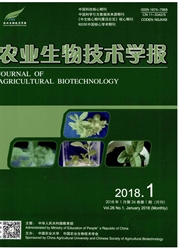

 中文摘要:
中文摘要:
输卵管蛋白(oviductin,Ovn)具有促进受精和早期胚胎发育的作用.本研究旨在克隆牦牛(Bos grunniens)输卵管蛋白基因(Ovn)的完整开放阅读框序列,并从基因和蛋白水平分析其在发情周期的表达差异.本研究RT-PCR克隆牦牛输卵管蛋白cDNA,并采用实时荧光定量PCR(quantitative Real-time PCR,qRT-PCR)和免疫组织化学方法分别分析Ovn在卵泡期前期阶段(卵泡直径3~6 mm)、卵泡期后期阶段(卵泡直径>6 mm)、黄体期前期阶段(可见一个或多个血体)和黄体期后期阶段(可见一个或多个黄体)输卵管伞部和壶腹部的表达差异.成功克隆出牦牛Ovn的cDNA序列(GenBank登录号:KF303541),其包含的完整开放阅读框由1 443个核苷酸组成,共编码480个氨基酸.序列分析显示,牦牛输卵管蛋白cDNA序列与黄牛(Bos taurus)和印度水牛(Bubalus bubalis)具有很高的同源性,Ovn的氨基酸序列进化树表明,牦牛输卵管蛋白与黄牛的同源性最高,达到99.1%,与水牛、绵羊(Ovis aries)和冠毛猕猴(Macaca radiate)的同源性依次为93.7%、88.1%和79.8%.qRT-PCR结果显示,卵泡期后期阶段输卵管蛋白mRNA 的表达最高,黄体期前期和黄体期后期阶段表达依次减少,卵泡期前期阶段相对表达量最低,而壶腹部和伞部的表达差异不显著.蛋白免疫标记在卵泡期后期和黄体期前期阶段较明显,其他阶段则减弱.本研究得到了包含完整开放阅读框的牦牛Ovn的cDNA序列,检测出发情周期中其卵泡期后期阶段输卵管表达最高,表明其在卵母细胞成熟和排卵过程中具有重要的生物学作用,为进一步研究其在提高受精率和早期胚胎发育率中的作用机制提供了一定的理论基础.
 英文摘要:
英文摘要:
Oviductin (Ovn) plays crucial role during fertilization and early embryonic development. The objective of this study was to clone the full open reading frame of yak (Bos grunniens) oviductin and to detect its different expression during the estrous cycle from mRNA and protein level. In this study, we cloned oviductin eDNA by RT-PCR, and analysed the expression of oviductin in oviductal ampulla and isthmus of yak in early follicular (follicles 3-6 mm), late follicular (with preponderant follicles 〉 6 mm), early luteal (one or more corpora hemorrhagica visible) and late luteal (one or more corpora lutea visible) by qRT-PCR (quantitative Real-time PCR) and immunohistochemistry. The oviductin cDNA of yak was successfully cloned, and the sequences had been submitted to GenBank, and accession number was KF303541, which contained the full open reading frame and determined to be 1 443 nucleotides encoding for a deduced protein of 480 amino acids. The sequence analysis revealed that oviductin eDNA sequences of yak shared very high homology with cattle and buffalo. The phylogenetic tree based on amino acid sequences of oviductin indicated that yak oviductin was closely related to its cattle counterpart, reached 99.1% with Bos taurus, followed by 93.7% with buffalo (Bubalus bubalis), 88.1% with sheep (Ovis aries), 79.8% with Macaca radiata, qRT-PCR results showed highest oviductin mRNA oviductin expression in the stage of late follicle, reduce in the stages of early luteal and late luteal. The expression of mRNA was lowest in the stages of early follicle. However, there was no difference between ampulla and isthmus. The prominent immunolabeling were observed in the late follicle and early luteal stages, which was reduced in other stages. In this study, we obtained eDNA sequence of yak oviductin containing an open reading frame, and found the highest expression in the stage of late follicle. It showed that oviductin has an important biological role in oocyte maturation and the process of
 同期刊论文项目
同期刊论文项目
 同项目期刊论文
同项目期刊论文
 期刊信息
期刊信息
